Topics
Category
Era
Jefferson Highway
Colorized postcard featuring a view of Jefferson Highway and River Drive in St. Cloud, with the Tenth Street bridge in the center left, ca. 1917.
The Jefferson Highway, established in 1915 and named for President Thomas Jefferson, was a product of the early twentieth century’s Good Roads movement. Its route followed existing roads that extended from Winnipeg to New Orleans. In this way it passed through Minnesota, Iowa, Missouri, Arkansas, Kansas, Oklahoma, Texas, and Louisiana on variant routes. Like other named routes, the highway faded from public awareness after the advent of the federal numbering system in 1926.
The Jefferson Highway was a product of the early-twentieth-century promotion of “good roads” for the emergent automobile. By the mid-1920s, the US had approximately 250 named automotive trails. Some, like the Jefferson, were designated as memorial roads.
The Jefferson was a north-south counterpart of the well-known Lincoln Memorial Highway, a transcontinental route that extended from Times Square in New York City to San Francisco. Another memorial highway, the Theodore Roosevelt International Highway, crossed the country from Portland, Maine, to Portland, Oregon.
Each of the named highways had a distinctive symbol that appeared on signs and telephone poles along its route. The Jefferson Highway’s logo consisted of the interlocking letters “JH” rendered in cobalt blue on a white background framed by top and bottom bands of cobalt. Like some of the other named highways, the Jefferson also had metal signs. Their design consisted of a white background with directional arrows, graphics of a pine tree and a palm tree, and the words “Jefferson Highway” and “Winnipeg-New Orleans.”
The Jefferson Highway, along with other named highways, was promoted by a private group of “boosters” who advocated for good roads and extolled the benefits of proximity to the route. The Jefferson Highway Association (JHA), which had formed in 1915, sent its general manager, Missouri businessman J. D. Clarkson, to Minnesota in 1916 to help finalize the route.
Three paths had been proposed for the highway that began from the Iowa border: one western; one central; and one eastern. Basing their decision on such factors as road conditions, accommodations, and scenery, the JHA selected the central route.
The Jefferson Highway in Minnesota passed such iconic state landmarks as the state capitol and the Cathedral of St. Paul. In that city’s northwest, it shared the route of the Yellowstone Trail along University Avenue. Further north, near Bemidji, it shared the route of the Roosevelt Highway and passed the famous statues of Paul Bunyan and Babe the Blue Ox. Near Little Falls, it followed the Mississippi River past Charles Lindbergh’s boyhood home and the road that was later designated part of the Great River Road.
The Jefferson Highway also passed through the state’s first state park, Itasca, known to generations of travelers and tourists as the headwaters of the Mississippi. It traversed the park and crossed the headwaters via a small bridge. Workers hired by the Civilian Conservation Corps (CCC) and Works Projects Administration (WPA) redesigned and rusticated the site in the 1930s and early 1940s.
Like other highways, the Jefferson inspired businesses along its route, such as cafes and garages, to reference the road in their names. The Jefferson Highway Transportation Company, for example, operated throughout Minnesota and Iowa along the route of the highway. The bus company was established in 1920; by 1925 it was acquired by the Zelle family, which continued to operate it as the Jefferson Lines.
Numerous highway associations, the rapidly increasing number of automobile travelers trying to follow a bewildering array of named highway markings, and varying state and local regulations, all contributed to the establishment of the federal numbering system in 1926. The Jefferson Highway became a series of federal, state, and county roads as well as city streets. This network includes US Route 65, US 10, US 71, University Avenue in St. Paul, and Broadway Avenue from Minneapolis to Robbinsdale. Whereas most of the Lincoln Highway became US Route 30 along Interstate 80 corridor, no single federal highway traverses most of the Jefferson’s original route in its entirety.
The Jefferson Highway and other named automobile routes, however, did not immediately disappear from public memory. The JHA, reorganized in 2011, has had annual conferences and has been working to preserve, promote and map the original route and its associated resources.
Bibliography
Henry Jr., Lyell D. The Jefferson Highway: Blazing the Way from Winnipeg to New Orleans. Iowa City: University of Iowa Press, 2016.
——— . “Following in the Lincoln’s Wake: The Jefferson Highway.” Lincoln Highway Forum 15, no. 4 (Summer 2008): 34–46.
Jefferson Transportation Company records, 1883–1996 (bulk 1913–1996)
Manuscript Collection, Minnesota Historical Society, St. Paul
http://www2.mnhs.org/library/findaids/00474.xml
Description: Records of a Minneapolis-based bus company that was also involved in retail and hotel projects in Minneapolis and Saint Paul. Includes business records of subsidiary, related, and acquired bus companies, and personal and business papers of long-time company president Edgar F. Zelle and other members of the Zelle family.
Sommer, Barbara W. Hard Work and a Good Deal: The Civilian Conservation Corps in Minnesota. St. Paul: Minnesota Historical Society Press, 2008.
“Story of the Minnesota Contest: Central Route Officially Adopted, St. Paul to Winnipeg.” Jefferson Highway Declaration 1, no. 7 (August 1916): 7–8.
Walsh, Margaret. “Minnesota’s ‘Mr. Bus’: Edgar F. Zelle and the Jefferson Highway Transportation Company.” Minnesota History 52, no. 8 (Winter 1991): 307–322.
http://collections.mnhs.org/MNHistoryMagazine/articles/52/v52i08p307-322.pdf
Weingroff, Richard F. “From Names to Numbers: The Origins of the U.S. Numbered Highway System.” AASHTO Quarterly (Spring 1997).
https://www.fhwa.dot.gov/infrastructure/numbers.cfm
Related Resources
Primary
Jefferson Highway Declaration. Des Moines, IA: Jefferson Highway Association, 1916–1918.Jefferson Highway: New Orleans–Winnipeg: From Pine to Palm. Des Moines, IA: Kenyong Company, Map Makers, 1917.
The Modern Highway. St. Joseph, MO: Jefferson Highway Association, 1919–1923.
Pines and Palms. St. Joseph, MO: International Jefferson Highway Association, 1923.
Proposed Route for Jefferson Highway: Through Northern Minnesota via Park Region and Red River Valley. Minnesota: N.p., [1916].
Secondary
Jefferson Highway: Winnipeg–New Orleans: Pikes Peak Ocean-to-Ocean Highway. Kansas City, MO: Automobile Route Book Company, 1921.
The Land of Ten Thousand Lakes Over Jefferson Highway, Minnesota. Minnesota: N.p., 1920.
Web
Jefferson Highway Association.
http://www.jeffersonhighway.org/
Minnesota Department of Transportation Library.
www.dot.state.mn.us/library
Stearns County Historical Museum.
www.stearns-museum.org
Morrison County Historical Society, Charles A, Weyerhaeuser Museum.
www.morrisoncountyhistory.org
Related Images
A section of the Jefferson Highway in Little Falls, photographed in November of 1922. At the time, the section of highway—175 miles—was the longest stretch of paved road in Minnesota. Cropped from a “Little Falls Paving Celebration” newsletter in the Mathias N. Koll papers, Manuscripts Collection, Minnesota Historical Society, St. Paul.
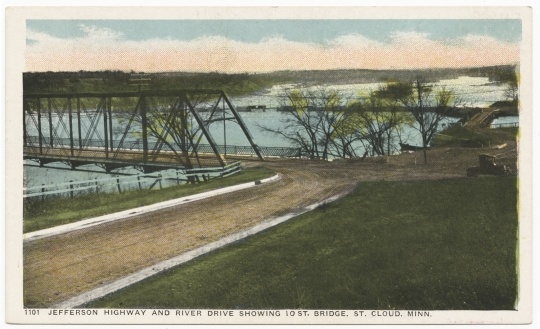
River Drive and Jefferson Highway, St. Cloud
Colorized postcard featuring a view of Jefferson Highway and River Drive in St. Cloud, with the Tenth Street bridge in the center left, ca. 1917.
Public domain
Holding Location
Articles
More Information
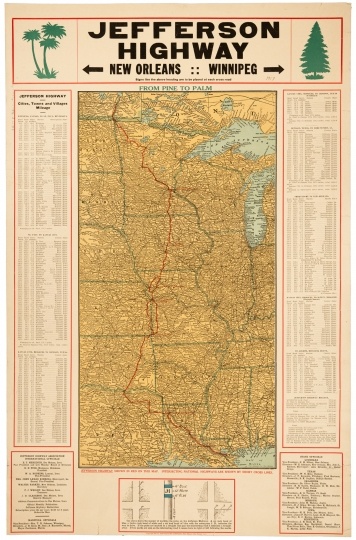
Map of the route of the Jefferson Highway
Map of the route of the Jefferson Highway, 1917. From the maps collection of the Minnesota Historical Society, St. Paul.
Public domain
Holding Location
Articles
More Information
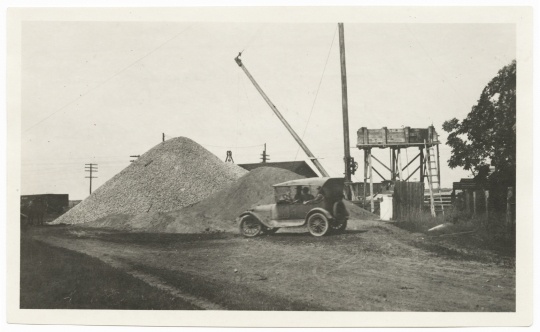
Construction of Jefferson Highway
Construction of Jefferson Highway. Photograph by C. S. Burdsol, 1919.
Public domain
Holding Location
Articles
More Information
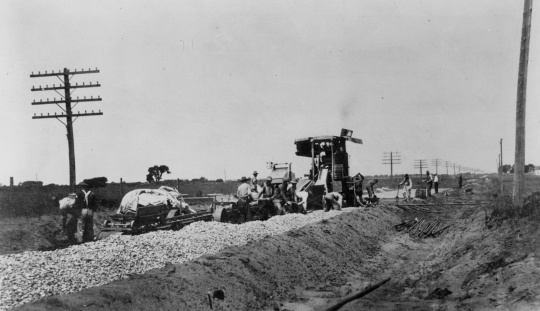
Construction of Jefferson Highway in Anoka County
Construction of Jefferson Highway in Anoka County, 1919.
Public domain
Holding Location
Articles
More Information
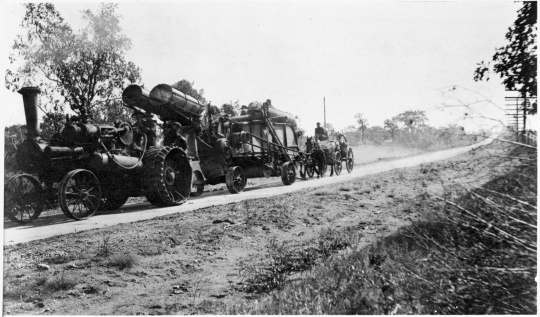
Traffic on Jefferson Highway
Traffic on Jefferson Highway, US Highway 10, near Elk River, on newly paved concrete, 1919.
Public domain
Holding Location
Articles
More Information
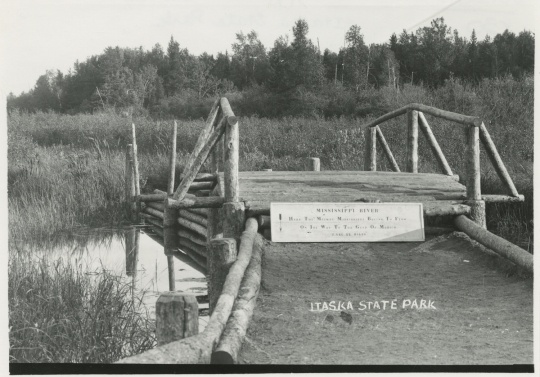
Source of the Mississippi River, Itasca State Park
Source of the Mississippi River, Itasca State Park, ca. 1920.
Public domain
Holding Location
Articles
More Information
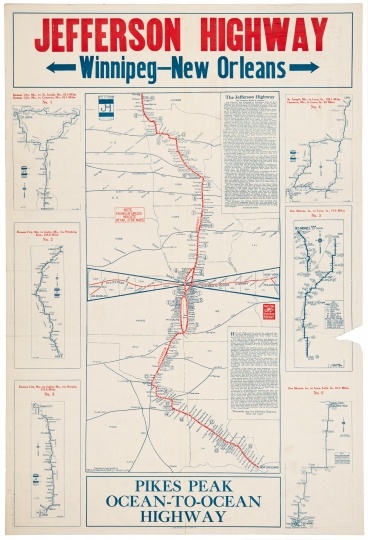
Map of the route of the Jefferson Highway, 1921
Map of the route of the Jefferson Highway, 1921. From the Jefferson Highway Company photo album (Jefferson Transportation Company records, box 67).
Public domain
Holding Location
Articles
More Information
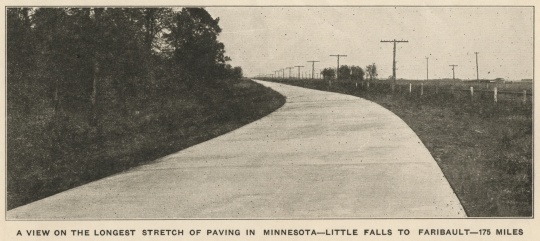
Section of the Jefferson Highway in Little Falls
A section of the Jefferson Highway in Little Falls, photographed in November of 1922. At the time, the section of highway—175 miles—was the longest stretch of paved road in Minnesota. Cropped from a “Little Falls Paving Celebration” newsletter in the Mathias N. Koll papers, Manuscripts Collection, Minnesota Historical Society, St. Paul.
Public domain
Holding Location
Articles
More Information
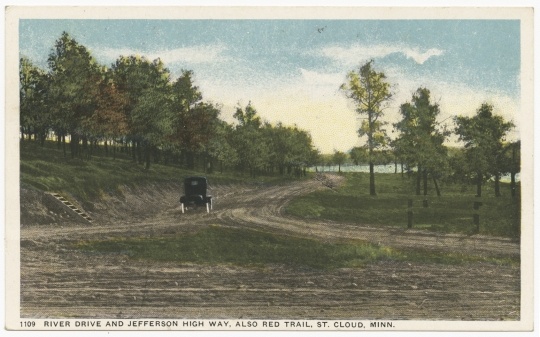
River Drive and Jefferson Highway, St. Cloud
Colorized postcard featuring a photograph of the intersection of River Drive and Jefferson Highway, St. Cloud, ca. 1918.
Public domain
Holding Location
Articles
More Information
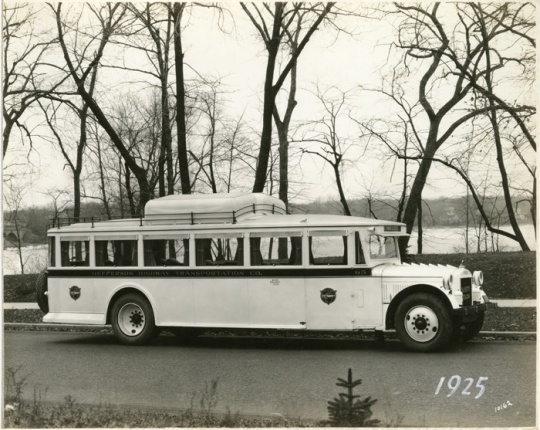
A Jefferson Highway Transportation Company bus on the Jefferson Highway, 1925
A Jefferson Highway Transportation Company bus on the Jefferson Highway, 1925. From the Jefferson Highway Company photo album (Jefferson Transportation Company records, box 67). Manuscripts collection, Minnesota Historical Society, St. Paul.
Holding Location
Articles
More Information
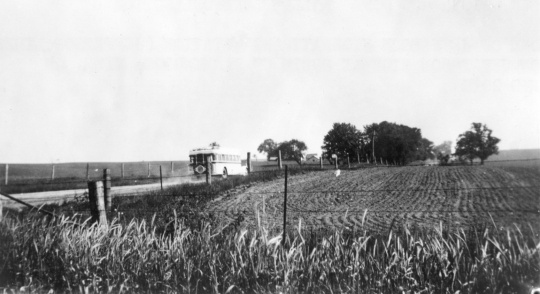
A Jefferson Highway Transportation Company bus on Jefferson Highway south of Farmington
A Jefferson Highway Transportation Company bus on Jefferson Highway south of Farmington, ca. 1925.
Holding Location
Articles
More Information
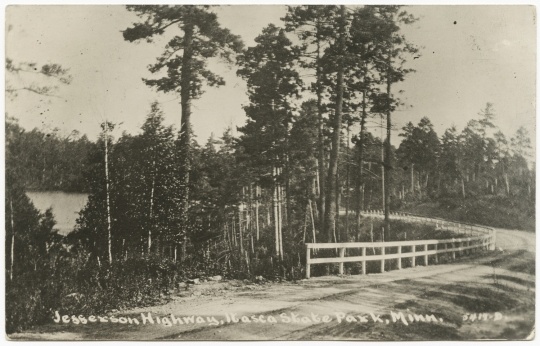
Jefferson Highway, Itasca State Park
Jefferson Highway inside Itasca State Park, ca. 1930.
Holding Location
Articles
More Information
Related Articles
Turning Point
In 1916 the Jefferson Highway Association finalizes the route of the Jefferson Highway, which begins in Winnipeg and terminates in New Orleans.
Chronology
1915
1916
1917
1917
1918
1920
1922
1930
1941
2011
Bibliography
Henry Jr., Lyell D. The Jefferson Highway: Blazing the Way from Winnipeg to New Orleans. Iowa City: University of Iowa Press, 2016.
——— . “Following in the Lincoln’s Wake: The Jefferson Highway.” Lincoln Highway Forum 15, no. 4 (Summer 2008): 34–46.
Jefferson Transportation Company records, 1883–1996 (bulk 1913–1996)
Manuscript Collection, Minnesota Historical Society, St. Paul
http://www2.mnhs.org/library/findaids/00474.xml
Description: Records of a Minneapolis-based bus company that was also involved in retail and hotel projects in Minneapolis and Saint Paul. Includes business records of subsidiary, related, and acquired bus companies, and personal and business papers of long-time company president Edgar F. Zelle and other members of the Zelle family.
Sommer, Barbara W. Hard Work and a Good Deal: The Civilian Conservation Corps in Minnesota. St. Paul: Minnesota Historical Society Press, 2008.
“Story of the Minnesota Contest: Central Route Officially Adopted, St. Paul to Winnipeg.” Jefferson Highway Declaration 1, no. 7 (August 1916): 7–8.
Walsh, Margaret. “Minnesota’s ‘Mr. Bus’: Edgar F. Zelle and the Jefferson Highway Transportation Company.” Minnesota History 52, no. 8 (Winter 1991): 307–322.
http://collections.mnhs.org/MNHistoryMagazine/articles/52/v52i08p307-322.pdf
Weingroff, Richard F. “From Names to Numbers: The Origins of the U.S. Numbered Highway System.” AASHTO Quarterly (Spring 1997).
https://www.fhwa.dot.gov/infrastructure/numbers.cfm
Related Resources
Primary
Jefferson Highway Declaration. Des Moines, IA: Jefferson Highway Association, 1916–1918.Jefferson Highway: New Orleans–Winnipeg: From Pine to Palm. Des Moines, IA: Kenyong Company, Map Makers, 1917.
The Modern Highway. St. Joseph, MO: Jefferson Highway Association, 1919–1923.
Pines and Palms. St. Joseph, MO: International Jefferson Highway Association, 1923.
Proposed Route for Jefferson Highway: Through Northern Minnesota via Park Region and Red River Valley. Minnesota: N.p., [1916].
Secondary
Jefferson Highway: Winnipeg–New Orleans: Pikes Peak Ocean-to-Ocean Highway. Kansas City, MO: Automobile Route Book Company, 1921.
The Land of Ten Thousand Lakes Over Jefferson Highway, Minnesota. Minnesota: N.p., 1920.
Web
Jefferson Highway Association.
http://www.jeffersonhighway.org/
Minnesota Department of Transportation Library.
www.dot.state.mn.us/library
Stearns County Historical Museum.
www.stearns-museum.org
Morrison County Historical Society, Charles A, Weyerhaeuser Museum.
www.morrisoncountyhistory.org













